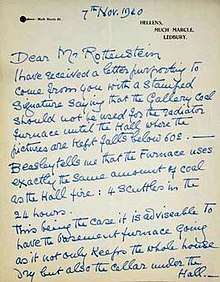Lady Helena Gleichen
Lady Helena Emily Gleichen, OBE, DStJ (1 February 1873 in London, England – 28 January 1947) was a British painter of landscapes, flowers, and animals, with a particular passion for horses.
Lady Helena Emily Gleichen | |
|---|---|
 Portrait of Lady Helena Gleichen from the Imperial War Museums | |
| Born | 1 February 1873 London, United Kingdom |
| Died | 28 January 1947 (aged 73) |
| Nationality | British |
| Known for | Painting |

Her brother, Lord Edward Gleichen (1863–1937), a professional soldier, wrote several books. Her sister, Lady Feodora Gleichen (1861–1922) was a sculptor. They were the children of Count Victor Gleichen aka Prince Victor of Hohenlohe-Langenburg, a half-nephew of Queen Victoria and himself a sculptor and naval officer, and his morganatic wife Laura Williamina Seymour, a daughter of Admiral Sir George Seymour.[1]
On 15 December 1885, the Court Circular announced the Queen's permission for Helena's mother to share her father's rank at the Court of St James's, and henceforth they were known as TSH Prince and Princess Victor of Hohenlohe-Langenburg. But the Queen did not extend that privilege to their children, although she confirmed use of their German style as count and countesses. On 12 June 1913 Helena and her sisters, the Countesses Feodora and Valda Gleichen, were granted precedence before the daughters of dukes in the peerage of England.[2]
She helped with illustrations for the Younghusband Expedition to Tibet in 1904. During World War I she abandoned her German titles, accepting demotion by the King to the style and rank of a marquess's daughter,[3] and headed the 4th Radiographic British Red Cross Unit stationed in the Villa Zucco in Cormons, Italy. She later received the Italian Bronze Medal of Military Valour and was invested as a Dame of Grace of the Order of St John of Jerusalem and as an OBE in 1920. She was a Fellow of the Society of Antiquaries.[4]
She worked from her father's former studio in St James's Palace opposite Friary Court. The family home was a rambling estate Hellens Manor at Much Marcle in Herefordshire, used during World War II by the Tate for the safe storage of art works. Gleichen organised her estate staff of some 80 people into a local home guard during World War II.[5][6]
She died in 1947, three days before her 74th birthday. Her memoir, Contacts and Contrasts, was published in 1940. A memorial plaque to her and her siblings is located at Golders Green.
Ancestry
| Ancestors of Lady Helena Gleichen | ||||||||||||||||||||||||||||||||||||||||||||||||||||||||||||||||||||||||||||||||||||||||||||||||||||||||||||||||||||||||||||||||||||||||||||||||||||||||||||||||||||||||||||||||||||||||||||||||||||||||||||||||||||||||||||||||||||||||||||||||||||||||||||||||||||||||||||||||||||||||||||||||||||||||||||||||||||||||||||||||||||||||||||||||||||||||||||||||||||||||||||||||||||||||||||||||||||||||||||||||||||||||||||||||||||||||||||||||||||||||||||||||||||||||||||||||||||||||||||||||||||||||||||||||||||||||||||||||||||||||||||||||||||||||||||||||||||||||||||||||||||||||||||||||||||||||||||||||
|---|---|---|---|---|---|---|---|---|---|---|---|---|---|---|---|---|---|---|---|---|---|---|---|---|---|---|---|---|---|---|---|---|---|---|---|---|---|---|---|---|---|---|---|---|---|---|---|---|---|---|---|---|---|---|---|---|---|---|---|---|---|---|---|---|---|---|---|---|---|---|---|---|---|---|---|---|---|---|---|---|---|---|---|---|---|---|---|---|---|---|---|---|---|---|---|---|---|---|---|---|---|---|---|---|---|---|---|---|---|---|---|---|---|---|---|---|---|---|---|---|---|---|---|---|---|---|---|---|---|---|---|---|---|---|---|---|---|---|---|---|---|---|---|---|---|---|---|---|---|---|---|---|---|---|---|---|---|---|---|---|---|---|---|---|---|---|---|---|---|---|---|---|---|---|---|---|---|---|---|---|---|---|---|---|---|---|---|---|---|---|---|---|---|---|---|---|---|---|---|---|---|---|---|---|---|---|---|---|---|---|---|---|---|---|---|---|---|---|---|---|---|---|---|---|---|---|---|---|---|---|---|---|---|---|---|---|---|---|---|---|---|---|---|---|---|---|---|---|---|---|---|---|---|---|---|---|---|---|---|---|---|---|---|---|---|---|---|---|---|---|---|---|---|---|---|---|---|---|---|---|---|---|---|---|---|---|---|---|---|---|---|---|---|---|---|---|---|---|---|---|---|---|---|---|---|---|---|---|---|---|---|---|---|---|---|---|---|---|---|---|---|---|---|---|---|---|---|---|---|---|---|---|---|---|---|---|---|---|---|---|---|---|---|---|---|---|---|---|---|---|---|---|---|---|---|---|---|---|---|---|---|---|---|---|---|---|---|---|---|---|---|---|---|---|---|---|---|---|---|---|---|---|---|---|---|---|---|---|---|---|---|---|---|---|---|---|---|---|---|---|---|---|---|---|---|---|---|---|---|---|---|---|---|---|---|---|---|---|---|---|---|---|---|---|---|---|---|---|---|---|---|---|---|---|---|---|---|---|---|---|---|---|---|---|---|---|---|---|---|---|---|---|---|---|---|---|---|---|---|---|---|---|---|---|---|---|---|---|---|---|---|---|---|---|---|---|---|---|---|---|---|---|---|---|---|---|---|---|---|---|---|---|---|---|---|---|---|---|---|---|---|---|---|---|---|---|---|---|---|---|---|---|---|---|---|---|---|---|---|---|---|---|---|---|---|---|---|---|---|---|---|---|---|---|---|---|---|---|---|---|---|---|---|---|---|---|---|---|---|---|---|---|---|---|---|---|---|---|---|---|---|---|---|---|---|---|---|---|---|---|---|---|---|---|---|---|---|---|---|---|---|---|---|---|---|---|---|---|---|---|---|---|
| ||||||||||||||||||||||||||||||||||||||||||||||||||||||||||||||||||||||||||||||||||||||||||||||||||||||||||||||||||||||||||||||||||||||||||||||||||||||||||||||||||||||||||||||||||||||||||||||||||||||||||||||||||||||||||||||||||||||||||||||||||||||||||||||||||||||||||||||||||||||||||||||||||||||||||||||||||||||||||||||||||||||||||||||||||||||||||||||||||||||||||||||||||||||||||||||||||||||||||||||||||||||||||||||||||||||||||||||||||||||||||||||||||||||||||||||||||||||||||||||||||||||||||||||||||||||||||||||||||||||||||||||||||||||||||||||||||||||||||||||||||||||||||||||||||||||||||||||||
References
- Atwood, Kathryn J. (2014). Women Heroes of World War I: 16 Remarkable Resisters, Soldiers, Spies, and Medics. Chicago Review Press. p. 108. ISBN 978-1-61374-686-8.
- "No. 28789". The London Gazette. 2 January 1914. p. 37.
- "No. 30551". The London Gazette. 1 March 1918. p. 2632.
- Find-a-Grave website
- Alexander Palace website
- Hellens Manor website Archived 25 January 2013 at Archive.today